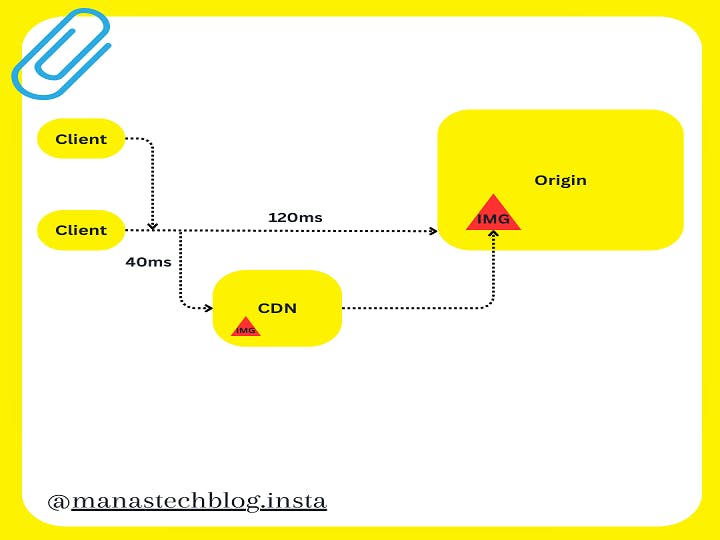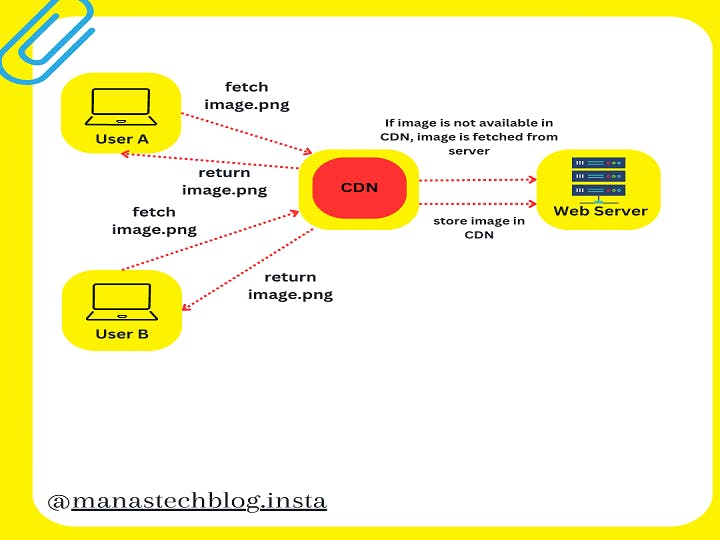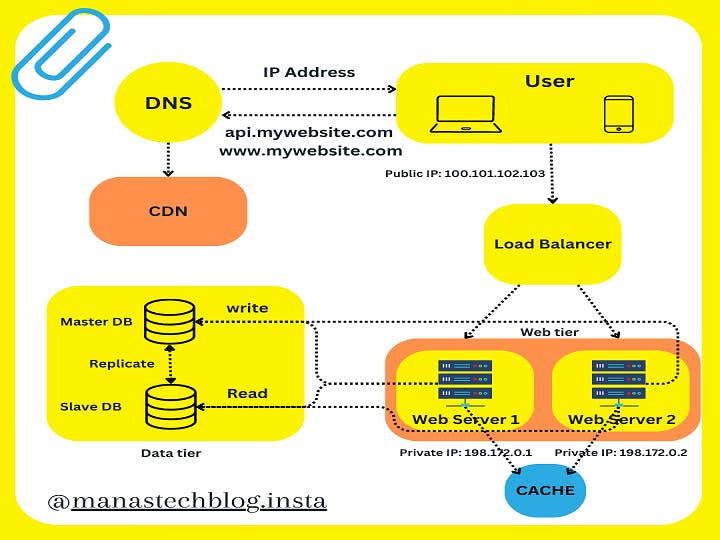System design refers to the process of conceptualizing and structuring a software system to address specific requirements. It involves identifying the system's components, their relationships, and interactions, and designing their interfaces. System design encompasses architectural decisions, data flow, communication protocols, algorithms, and storage considerations. The goal is to create a robust, scalable, and efficient system that meets functional and non-functional requirements such as performance, reliability, and security. It requires knowledge of software engineering principles, design patterns, and trade-offs. System design is crucial in building complex software applications that effectively solve real-world problems.
A CDN, or Content Delivery Network, is a distributed network infrastructure that helps deliver content, such as web pages, images, videos, and other media, to end users quickly and efficiently. It plays a crucial role in system design, especially for applications that require high performance, scalability, and global reach.
Understanding CDN
A CDN, or Content Delivery Network, is a distributed network infrastructure that helps deliver content, such as web pages, images, videos, and other media, to end users quickly and efficiently. It plays a crucial role in system design, especially for applications that require high performance, scalability, and global reach.
The primary purpose of a CDN is to reduce latency and improve the user experience by bringing the content closer to the end users. Instead of serving content from a single central server, a CDN distributes content across multiple servers strategically located in various geographical locations, often referred to as edge servers or points of presence (PoPs). These edge servers are deployed in data centers around the world and are designed to handle a large number of simultaneous user requests.
When a user requests content from a website or application, the CDN automatically determines the nearest edge server based on factors such as network proximity and server availability. The edge server then delivers the content to the user, minimizing the round-trip time required for the data to travel from the server to the user's device. By caching and serving content from these distributed edge servers, CDNs reduce the load on the origin server and improve response times.
Understanding How CDN Improves Load Time
Suppose you have a website that serves images to users across the globe. Without a CDN, your website has a single server located in New York, USA, where all the images are stored.
User Request without CDN: A user from Australia visits your website and requests an image. Since the server is in New York, the image data needs to travel a long distance from the server to the user's device in Australia. This results in increased latency and longer load times. The user experiences a delay in accessing the image.
User Request with CDN: Now, let's consider the same scenario, but this time your website is integrated with a CDN. The CDN has multiple edge servers distributed globally, including one in Sydney, Australia.
When the user requests the image, the CDN automatically routes the request to the edge server in Sydney, which is geographically closer to the user. Since the image is already cached on the edge server, it can be delivered quickly to the user's device without having to contact the origin server.
As a result, the image is loaded significantly faster than in the previous scenario without the CDN. The reduced distance between the edge server and the user's device reduces latency, resulting in a much-improved load time for the image.
By leveraging the CDN's distributed network, the load time is improved due to the following factors:
Reduced Network Distance: CDNs bring content closer to users by placing edge servers in strategic locations worldwide. Users can access content from the nearest edge server, reducing the physical distance data needs to travel. This minimizes the time it takes for data to reach the user, resulting in faster load times.
Load Balancing: CDNs balance the load across multiple edge servers. If one server is experiencing high traffic or is temporarily unavailable, the CDN can route requests to other nearby servers. This ensures efficient utilization of resources and prevents bottlenecks, resulting in improved load times.
Caching: CDNs cache content on edge servers, storing frequently accessed data closer to users. When a user requests the content, the CDN serves it directly from the cache, eliminating the need to fetch it from the origin server. This reduces the load on the origin server and further improves load times.
Understanding CDN Workflow
CDNs (Content Delivery Networks) work by distributing content across multiple edge servers strategically placed in different geographic locations.
Here is a step-by-step overview of how a CDN typically works and the workflow involved:
Content Distribution: The origin server is the main source where the content (web pages, images, videos, etc.) resides. The CDN provider works with the content owner to distribute this content across its network of edge servers. The content is typically replicated or cached onto these edge servers.
User Request: When a user requests content from a website or application, their request is first routed to the nearest edge server based on factors like network proximity, server availability, and possibly even performance-based metrics.
Edge Server Response: The edge server receives the user request and checks if it has the requested content available in its cache. If the content is present, the edge server directly serves it to the user without needing to contact the origin server. This caching mechanism helps reduce latency and improve response times.
Cache Miss: If the edge server doesn't have the requested content in its cache (cache miss), it acts as a proxy and forwards the request to the origin server.
Origin Server Interaction: The origin server receives the request from the edge server and responds with the requested content.
Content Delivery: Upon receiving the content from the origin server, the edge server caches the content for future requests and delivers it to the user. The edge server may also employ various optimizations, such as compression and minification, to further enhance performance.
Content Updates: CDNs employ various mechanisms to ensure that the content remains up to date across edge servers. When the content on the origin server is updated, the CDN provider may use techniques like time-based caching, content versioning, or invalidation to ensure that the new content is distributed to the edge servers and older versions are removed from the cache.
Load Balancing: CDNs often use load balancing techniques to distribute user requests among multiple edge servers, ensuring optimal utilization of resources and preventing any single server from being overloaded.
Analytics and Reporting: CDNs typically provide analytics and reporting tools to track various metrics like traffic patterns, user engagement, caching efficiency, and performance. This data helps content owners and CDN providers monitor and optimize the content delivery process.
Throughout this workflow, CDNs continuously optimize content delivery by considering factors such as network conditions, server availability, user location, and content popularity. By bringing content closer to end users and reducing the distance data needs to travel, CDNs improve the performance, scalability, and reliability of websites and applications.
Implementing CDN In System Design Architecture
In the above figure, we have used CDN in designing our System.
All the static contents like static html pages, CSS and JS are served by CDN, which gives better performance to our system.
We have also used Cache in our system design to cache data of our database, which overall increase the performance and improve the response time of our system.
Some CDN Considerations
When implementing a CDN in a system design architecture, here are some steps and considerations to follow:
Evaluate Content and Traffic: Assess the types of content (e.g., static files, dynamic pages, media) and the anticipated traffic patterns of your application. Determine which content would benefit the most from CDN acceleration and prioritize accordingly.
Choose a CDN Provider: Research and select a reliable CDN provider that aligns with your requirements. Consider factors such as global network coverage, performance, scalability, security features, pricing, and integration options.
CDN Integration: Integrate the CDN into your system architecture. The specific integration process depends on the CDN provider and your application's technical stack. Typically, you'll need to update DNS settings to route traffic through the CDN and configure caching rules and content delivery settings.
Content Distribution Strategy: Determine which content should be distributed through the CDN. Typically, static files like images, CSS, JavaScript, and other assets are prime candidates. Some CDNs also support dynamic content caching and acceleration.
Caching Policies: Configure caching policies on the CDN to control how content is cached and for how long. Define rules based on file types, expiration headers, and cache-control directives. Strike a balance between caching durations to ensure freshness while optimizing performance.
Content Purging and Invalidation: Plan how you'll handle content updates or changes. Establish mechanisms to purge or invalidate cached content when updates occur on the origin server. This ensures that users receive the latest version of the content.
Load Balancing: Leverage the CDN's load balancing capabilities to distribute traffic across multiple origin servers. This helps distribute load, improve availability, and handle traffic spikes effectively.
Security Measures: Utilize the security features provided by the CDN, such as DDoS protection, SSL/TLS termination, and WAF capabilities. Configure security settings to protect your system and ensure secure content delivery.
Monitoring and Analytics: Set up monitoring and analytics tools provided by the CDN to gain insights into performance, traffic patterns, cache utilization, and user behavior. This data helps optimize the CDN configuration and troubleshoot any issues.
Testing and Optimization: Conduct thorough testing to ensure that the CDN is properly integrated and functioning as expected. Continuously monitor and optimize the CDN configuration to maximize performance and user experience.
Remember that CDN implementation may require collaboration between your development team and the CDN provider's support team. It's essential to follow best practices and leverage the expertise of the CDN provider to ensure successful integration and optimal performance of your system.
Benefits of CDN
CDNs offer several benefits for system design:
Improved Performance: By reducing latency and network congestion, CDNs deliver content faster, resulting in improved page load times and a better user experience. Users perceive faster loading times and are more likely to stay engaged with the application.
Scalability: CDNs can handle high traffic volumes and distribute the load across multiple servers. This scalability helps handle sudden spikes in traffic, such as during peak usage periods or when popular content goes viral.
Global Reach: CDNs have a global network of edge servers, allowing content to be delivered from the server nearest to the user's location. This reduces the distance data must travel, resulting in faster delivery times, regardless of the user's geographic location.
Reliability: CDNs improve the reliability and availability of content by employing redundancy. If one edge server fails or becomes overloaded, requests are automatically routed to other nearby servers, ensuring content delivery continues uninterrupted.
Bandwidth Savings: CDNs help reduce the bandwidth requirements on the origin server by caching and serving frequently accessed content from edge servers. This can lead to significant cost savings, especially for applications with heavy media content.
Security: CDNs can provide additional security features, such as DDoS mitigation, SSL/TLS termination, and web application firewall (WAF) capabilities. These features help protect against various types of attacks and ensure the integrity of the content being delivered.
Summarizing Up
Overall, CDNs are essential components in system design, particularly for applications with global reach and high traffic requirements. By leveraging a CDN, businesses can enhance the performance, scalability, and reliability of their applications, resulting in improved user experiences and optimized content delivery.
In summary, CDNs improve load times by reducing network distance, balancing traffic, and caching content closer to users. By bringing content closer to the user's location and minimizing the distance data needs to travel, CDNs significantly enhance the speed and efficiency of content delivery, resulting in faster load times and a better user experience.




